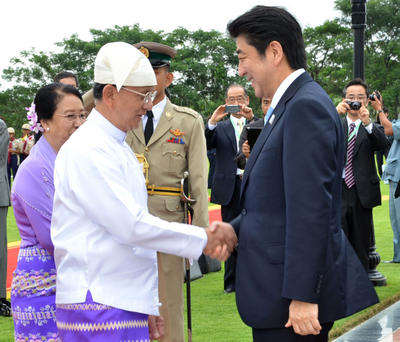The basic principles of Japanese aid policy, enshrined in the ODA Charter, were enacted as a cabinet decision in June 1992 under the then prime minister, Kiichi Miyazawa. Reflecting the post-Cold War zeitgeist, the ODA Charter bluntly prohibited the use of foreign aid for military purposes. It also stressed that full attention should be paid to efforts to promote democratisation and to protect human rights and freedoms.
Ten years later, then prime minister Junichiro Koizumi toned down the principles of the ODA Charter in order to quell the criticisms. The revised ODA Charter stipulated that the use of ODA for military purposes should be avoided and that attention should be paid to efforts to promote human rights and freedoms in developing countries. After the revision of the ODA charter the criticisms diminished. For example, the Japanese government had been repeatedly criticised for providing foreign aid to Myanmar. The revision of the ODA Charter made it easier for the Japanese government to justify the provision of assistance to Myanmar because Yangon was making some efforts to improve human rights condition.
The recent attempts by Prime Minister Abe at reforming Japanese aid policy are more radical and, therefore, more problematic. Abe has proclaimed a policy of ‘proactive pacifism’ with the aim of overhauling Japan’s military policy and ensuring Japan plays a more vigorous role in international politics. As part of this policy Abe has recently introduced three key military reforms.
First, in April 2014, Abe abolished Japan’s self-imposed ban on exporting military weapons. This gave the green light to selling missile components to the United States in July 2014.
Second, in July 2014, Abe reinterpreted the Article 9 ‘peace clause’ of the Japanese constitution via a cabinet decision. The new interpretation allows Japan’s Self-Defense Forces to exercise the right to collective self-defence under limited conditions. Ironically, the traditionally pacifist New Komeito, the coalition partner of the Liberal Democratic Party, played a role in the reinterpretation in order to remain in the coalition government.
Third, Abe has set his sights on nullifying specific principles of Japanese ODA, which would allow Japan to use ODA to support foreign armed forces. So far, the panel of specialists has recommended abolishing the total ban on providing ODA to a foreign military. But the panel has stressed that the provision of foreign aid should be limited only to non-military activities conducted by foreign armed forces, such as disaster relief activities.
Despite this condition, there are legitimate concerns about a loose definition of ‘non-military activities’. For example, some groups, such as NGOs and media organisations, are concerned about the provision of Japanese aid to foreign militaries to patrol coastal areas or national borders. Due to the lack of a precise definition of ‘non-military’ activities, aid for these purposes could be classified as non-military assistance which could provoke a negative international response. Japanese ODA has faced numerous criticisms from the OECD for not giving aid to countries most in need and instead focusing on countries and regions where Japan has economic interests. Giving ODA for ‘non-military’ assistance could further divert the limited and diminishing foreign aid funds.
The Abe administration is striving to convince other countries, especially its neighbours China and South Korea, that the changes in Japanese ODA policy aim to promote peace through supporting non-military activities.
Japanese foreign minister Fumio Kishida has said that development aid is ‘Japan’s biggest diplomatic tool’. But it is likely that the changes in Japan’s foreign aid policy will be viewed by some as an unwelcome and provocative decision.
Fumitaka Furuoka is a visiting senior research fellow at Asia-Europe Institute, University of Malaya. He is the author of the book New Challenges for Japan’s Official Development Assistance (ODA) Policy: Human Rights, Democracy and Aid Sanctions.

